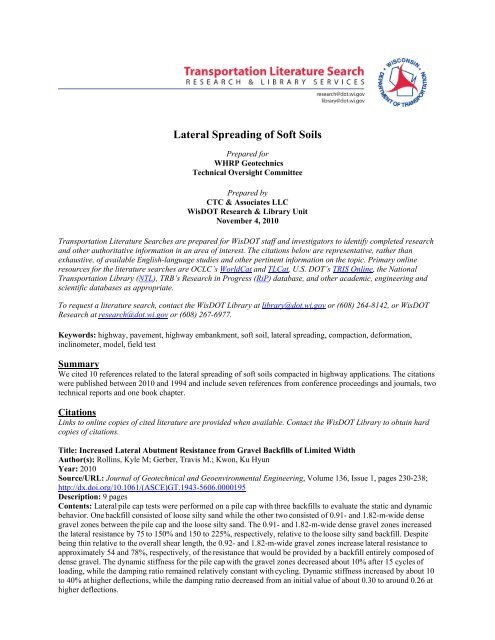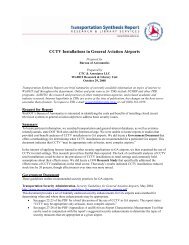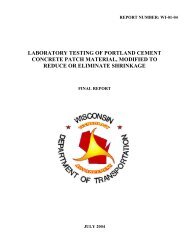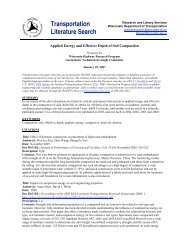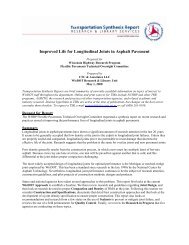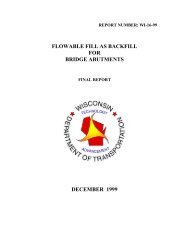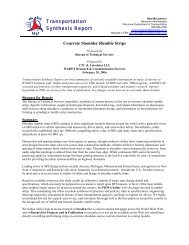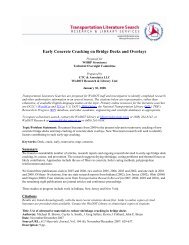Lateral Spreading of Soft Soils - WisDOT Research
Lateral Spreading of Soft Soils - WisDOT Research
Lateral Spreading of Soft Soils - WisDOT Research
Create successful ePaper yourself
Turn your PDF publications into a flip-book with our unique Google optimized e-Paper software.
<strong>Lateral</strong> <strong>Spreading</strong> <strong>of</strong> S<strong>of</strong>t <strong>Soils</strong><br />
Prepared for<br />
WHRP Geotechnics<br />
Technical Oversight Committee<br />
Prepared by<br />
CTC & Associates LLC<br />
<strong>WisDOT</strong> <strong>Research</strong> & Library Unit<br />
November 4, 2010<br />
Transportation Literature Searches are prepared for <strong>WisDOT</strong> staff and investigators to identify completed research<br />
and other authoritative information in an area <strong>of</strong> interest. The citations below are representative, rather than<br />
exhaustive, <strong>of</strong> available English-language studies and other pertinent information on the topic. Primary online<br />
resources for the literature searches are OCLC’s WorldCat and TLCat, U.S. DOT’s TRIS Online, the National<br />
Transportation Library (NTL), TRB’s <strong>Research</strong> in Progress (RiP) database, and other academic, engineering and<br />
scientific databases as appropriate.<br />
To request a literature search, contact the <strong>WisDOT</strong> Library at library@dot.wi.gov or (608) 264-8142, or <strong>WisDOT</strong><br />
<strong>Research</strong> at research@dot.wi.gov or (608) 267-6977.<br />
Keywords: highway, pavement, highway embankment, s<strong>of</strong>t soil, lateral spreading, compaction, deformation,<br />
inclinometer, model, field test<br />
Summary<br />
We cited 10 references related to the lateral spreading <strong>of</strong> s<strong>of</strong>t soils compacted in highway applications. The citations<br />
were published between 2010 and 1994 and include seven references from conference proceedings and journals, two<br />
technical reports and one book chapter.<br />
Citations<br />
Links to online copies <strong>of</strong> cited literature are provided when available. Contact the <strong>WisDOT</strong> Library to obtain hard<br />
copies <strong>of</strong> citations.<br />
Title: Increased <strong>Lateral</strong> Abutment Resistance from Gravel Backfills <strong>of</strong> Limited Width<br />
Author(s): Rollins, Kyle M; Gerber, Travis M.; Kwon, Ku Hyun<br />
Year: 2010<br />
Source/URL: Journal <strong>of</strong> Geotechnical and Geoenvironmental Engineering, Volume 136, Issue 1, pages 230-238;<br />
http://dx.doi.org/10.1061/(ASCE)GT.1943-5606.0000195<br />
Description: 9 pages<br />
Contents: <strong>Lateral</strong> pile cap tests were performed on a pile cap with three backfills to evaluate the static and dynamic<br />
behavior. One backfill consisted <strong>of</strong> loose silty sand while the other two consisted <strong>of</strong> 0.91- and 1.82-m-wide dense<br />
gravel zones between the pile cap and the loose silty sand. The 0.91- and 1.82-m-wide dense gravel zones increased<br />
the lateral resistance by 75 to 150% and 150 to 225%, respectively, relative to the loose silty sand backfill. Despite<br />
being thin relative to the overall shear length, the 0.92- and 1.82-m-wide gravel zones increase lateral resistance to<br />
approximately 54 and 78%, respectively, <strong>of</strong> the resistance that would be provided by a backfill entirely composed <strong>of</strong><br />
dense gravel. The dynamic stiffness for the pile cap with the gravel zones decreased about 10% after 15 cycles <strong>of</strong><br />
loading, while the damping ratio remained relatively constant with cycling. Dynamic stiffness increased by about 10<br />
to 40% at higher deflections, while the damping ratio decreased from an initial value <strong>of</strong> about 0.30 to around 0.26 at<br />
higher deflections.
Title: A Framework for 3D Nonlinear Ground-Foundation Analysis<br />
Author(s): Lu, Jinchi; Elgamal, Ahmed; Shantz, Thomas<br />
Year: 2009<br />
Source/URL: 2009 GeoHunan International Conference, pages 189-196; http://tris.trb.org/view.aspx?id=900844<br />
Description: 8 pages<br />
Contents: Three-dimensional nonlinear finite element simulations are becoming increasingly feasible for<br />
transportation geotechnical applications. This paper presents a robust and versatile framework that helps streamline<br />
the use <strong>of</strong> finite elements for seismic response <strong>of</strong> soil-structure systems. In this regard, a Windows-based graphicaluser-interface<br />
OpenSeesPL is developed for pile-ground interaction analysis. Particularly suited to seismic<br />
applications, the open-source computational platform OpenSees is employed throughout. OpenSeesPL allows<br />
convenient studies <strong>of</strong> three-dimensional seismic (earthquake) and/or push-over pile analyses. Various ground<br />
modification scenarios may be also addressed by appropriate specifications <strong>of</strong> the material within the pile zone. To<br />
illustrate the capabilities <strong>of</strong> OpenSeesPL, two studies are presented in this paper. <strong>Lateral</strong> spreading effects on pile<br />
foundations are modeled, followed by an investigation <strong>of</strong> ground remediation in a mildly sloping silt stratum. Along<br />
with the insights gained from these studies, the reported effort aims to highlight the analysis framework capabilities<br />
and range <strong>of</strong> potential applications.<br />
Title: Geogrid-Reinforced Roadway Embankment on S<strong>of</strong>t <strong>Soils</strong>: A Case Study<br />
Author(s): Vega-Meyer, Reinaldo; Garrido, Roberto Sosa; Piedrabuena, Alberto Ramírez; Larios, Ignacio Narezo;<br />
Lapuente, Ramón Pico<br />
Year: 2007<br />
Source/URL: S<strong>of</strong>t Soil Engineering: Proceedings <strong>of</strong> the Fourth International Conference on S<strong>of</strong>t Soil Engineering,<br />
pages 129-138; http://www.crcnetbase.com/doi/abs/10.1201/9781439833926.pt2<br />
Description: 10 pages<br />
Contents: Building earth structures on s<strong>of</strong>t soils is one <strong>of</strong> the toughest challenges in civil engineering. Due to the fill<br />
embankment and surcharges, the settlements associated to the overburden pressures are one <strong>of</strong> the major concerns in<br />
roadway embankment construction. Several methods <strong>of</strong> support improvement have been in practice for years (e.g.<br />
excavation/fill replacement, stone filling, Corduroy, etc.), but recently, geosynthetic reinforcement has been<br />
successfully incorporated as an efficient way to improve the weak soil conditions. This paper focuses on a case<br />
study that introduces a geogrid-reinforced roadway embankment located in the Texcoco Lake, near Mexico City,<br />
Mexico. The structure consists <strong>of</strong> an embankment with variable heights to be built in two different conditions: dry<br />
and saturated. The most critical section was in the saturated zone (lake) where the maximum embankment height<br />
was 2.80m and the water level was at 1.80 m, leaving only 1.0m <strong>of</strong> dry embankment body. The embankment was<br />
built on highly compressible saturated clay layers up to 40.0m deep, and moisture <strong>of</strong> up to 300%. The paper presents<br />
project design information, settlement observations, and performance evaluation. The performance <strong>of</strong> the<br />
embankment was observed during and after construction using inclinometers, and deep and surface surveying<br />
equipment. A presentation <strong>of</strong> this performance and results about the predicted vs. actual embankment settlements are<br />
included in the paper.<br />
Title: Characteristics and Engineering Properties <strong>of</strong> the S<strong>of</strong>t Soil Layer in Highway Soil Subgrades<br />
Author(s): Hopkins, Tommy C.; Beckham, Tony L.; Sun, Liecheng<br />
Year: 2006<br />
Source/URL: Kentucky Transportation Cabinet final report;<br />
http://www.ktc.uky.edu/Reports/KTC_06_13_SPR_270_03_1F.pdf<br />
Description: 101 pages<br />
Contents: The objective <strong>of</strong> this research was to examine the conditions and characteristics <strong>of</strong> soil subgrades that had<br />
been stabilized using mechanical compaction. Goals <strong>of</strong> the study are to identify and examine the engineering<br />
properties and behavior <strong>of</strong> the “s<strong>of</strong>t layer’ <strong>of</strong> material observed at the top <strong>of</strong> untreated, highway pavement soil<br />
subgrades. Alternative methods <strong>of</strong> preventing, or mitigating, the development <strong>of</strong> the s<strong>of</strong>t layer are discussed.<br />
Evidence is presented that shows that a s<strong>of</strong>t layer <strong>of</strong> soil frequently develops at the top <strong>of</strong> untreated, highway soil<br />
subgrades. Data are presented that show strengths obtained from mechanical compaction are largely destroyed when<br />
untreated compacted soils are exposed to moisture. California Bearing Ratio (CBR) values <strong>of</strong> compacted clayey<br />
soils initially are high but become small when exposed to saturation. In situ CBR values measured at the tops <strong>of</strong><br />
untreated subgrades, where mechanical compaction was the only means used to stabilize the soil subgrade, were<br />
smaller than unsoaked and soaked laboratory Kentucky CBR values. At the 85th percentile test value, the laboratory<br />
KYCBR value <strong>of</strong> compacted, unsoaked clayey specimens was 11.5 while the CBR value <strong>of</strong> soaked specimens was<br />
3.0. For comparison, the in situ CBR value <strong>of</strong> untreated subgrades at the 85th percentile test value, as shown in this<br />
study, was only 2. Using a bearing capacity model, based on limit equilibrium <strong>of</strong> layered media, bearing capacity<br />
2
analyses <strong>of</strong> flexible pavement sections were performed. The analyses show that when the in situ CBR is equal to or<br />
below 3, the pavement was unstable, i.e., the factor <strong>of</strong> safety against failure was 1.0 or below. However, when the in<br />
situ CBR value was 6, or greater, the pavement was generally stable and the factor <strong>of</strong> safety was 1.5, or greater.<br />
Chemical admixture stabilization <strong>of</strong> soil subgrades is the most effective means <strong>of</strong> maintaining large CBR values<br />
during construction and throughout the life <strong>of</strong> the pavement. In situ CBR values at the 85th percentile <strong>of</strong> tests<br />
performed on the tops <strong>of</strong> soil subgrades treated chemically with lime kiln dust, hydrated lime, and portland cement<br />
and that had been in place for 8 to 15 years were 24, 27, and 59, respectively. At the 85th percentile test value, in<br />
situ CBR values <strong>of</strong> chemically treated subgrades were about 12 to 30 times larger than the in situ CBR value <strong>of</strong> 2 <strong>of</strong><br />
untreated subgrades.<br />
Title: Time-Dependent Behaviour <strong>of</strong> S<strong>of</strong>t <strong>Soils</strong> During Embankment Construction – A Numerical Study<br />
Author(s): Brinkgreve, R. B. J.<br />
Year: 2004<br />
Source/URL: Chapter 89 <strong>of</strong> Numerical Models in Geomechanics, pages 631-637;<br />
http://www.crcnetbase.com/doi/abs/10.1201/9781439833780.ch89<br />
Description: 7 pages<br />
Contents: In this paper the results <strong>of</strong> a numerical study are presented in which the construction <strong>of</strong> an embankment<br />
on s<strong>of</strong>t soils is simulated using the finite element method. Three different models are compared: The Mohr-Coulomb<br />
model, the Modified Cam-Clay model and a creep model that is based on Modified Cam-Clay. It will be shown that<br />
advanced soil models will predict horizontal deformations away from the embankment (lateral spreading) during the<br />
consolidation phase, as generally observed in practice, whereas the simple Mohr-Coulomb model will unrealistically<br />
predict horizontal deformations towards the embankment (lateral confinement) due to the elastic compaction during<br />
consolidation. The key issue is to take sufficient irreversible shear deformation during the consolidation phase into<br />
account. Even after consolidation, horizontal deformations may continue to increase. This can only be predicted if<br />
creep effects are taken into account. It is shown in which way certain parameters in the creep model influence the<br />
computational results and how parameters should be selected in order to make realistic predictions.<br />
Title: Design <strong>of</strong> Short Aggregate Piers to Support Highway Embankments<br />
Author(s): White, David J.; Suleiman, Muhannad T.<br />
Year: 2004<br />
Source/URL: Transportation <strong>Research</strong> Board 83rd Annual Meeting; http://www.gfcwest.com/tech_papers/TP29.pdf<br />
Description: 36 pages<br />
Contents: (Excerpt from page 18 <strong>of</strong> the PDF) In addition to vertical settlements, lateral spreading <strong>of</strong> the<br />
embankment foundation soils should be given consideration, especially for sensitive structures such as culverts and<br />
utilities where lateral spreading effects can be a serious problem (8). During embankment fill placement, stress<br />
applied to the foundation soil can result in exceeding the preconsolidation pressure in the foundation soils. When<br />
this occurs, continued fill placement results in undrained shear distortion under constant effective vertical stress<br />
(36). Case histories show that lateral displacement (Δδ L<br />
) is approximately equal to the vertical settlement (Δδ V<br />
) for<br />
undrained loading conditions. For long-term drained conditions, however, lateral displacement has been observed to<br />
be a smaller fraction <strong>of</strong> the vertical settlement (37). Assuming: (1) aggregate pier installation renders the matrix soil<br />
into an overconsolidated state as described by Handy (18); (2) stress concentrates on the pier elements; and (3) piers<br />
act as a drainage pathway to facilitate a drained response, Equation 15 can be used as a simplified empirical solution<br />
to estimate lateral spreading.<br />
(15)<br />
Title: Settlement Calculations <strong>of</strong> a Highway Embankment on S<strong>of</strong>t Ground<br />
Author(s): Herle, I.; Herle, V.; Novotna, I.; Karcher, C.; Nybel, K.<br />
Year: 1999<br />
Source/URL: Twelfth European Conference on Soil Mechanics and Geotechnical Engineering, pages 1089-94;<br />
http://tris.trb.org/view.aspx?id=514772<br />
Description: 6 pages<br />
Contents: The settlement <strong>of</strong> a highway embankment on s<strong>of</strong>t soil is calculated using a standard method <strong>of</strong> the<br />
deformation modulus and compared with a more sophisticated approach using hypoplastic and viscoplastic models.<br />
Advantages <strong>of</strong> realistic soil models are discussed and a comparison with the measured in situ settlement is given.<br />
3
Title: Construction-Engineering Techniques for S<strong>of</strong>t Ground<br />
Author(s): Gale, S. M.<br />
Year: 1998<br />
Source/URL: Geotechnical Fabrics Report, Industrial Fabrics Association International, pages 42-45;<br />
http://tris.trb.org/view.aspx?id=487600<br />
Description: 4 pages<br />
Contents: As granular fills and excavation costs have increased, many municipalities, counties, and state<br />
departments <strong>of</strong> transportation have chosen the staged-loading approach with a single geotextile layer, or a composite<br />
layer <strong>of</strong> a geogrid and a geotextile for reinforcing road embankments on s<strong>of</strong>t soil. This article reviews construction<br />
monitoring for this technique. The first step in the construction process is to prequalify the soil and geosynthetic<br />
materials based on the specification. A preconstruction meeting is essential to confirm that specification details are<br />
adhered to; this article includes a checklist <strong>of</strong> details. Designs for embankments on s<strong>of</strong>t and organic soils typically<br />
are based on limit-equilibrium stability analyses and an evaluation <strong>of</strong> bearing capacity, lateral spreading, and<br />
undrained and drained creep. The designer should analyze both total and effective stresses. When building on s<strong>of</strong>t<br />
and organic soils, it is also critical to monitor excess pore pressures created within the subsoil as a result <strong>of</strong><br />
embankment loading. Pneumatic piezometers are typically used for monitoring. Embankment-settlement monitoring<br />
is usually the least expensive and most meaningful parameter to obtain during construction. Continued settlement<br />
indicates dissipation <strong>of</strong> excess pore pressure and shear-strength gain. <strong>Lateral</strong> displacement <strong>of</strong> soil during<br />
embankment placement should be expected. The degree and location <strong>of</strong> movement can indicate creep-strain or<br />
potential failure.<br />
Title: Vertical and Horizontal Deformations <strong>of</strong> Foundations and Embankments<br />
Author(s): Yeung, Albert T. (ed.); Félio, Guy Y. (ed.)<br />
Year: 1994<br />
Source/URL: ASCE conference Settlement ’94; http://cedb.asce.org/cgi/WWWdisplay.cgi?90309<br />
Description: 1940 pages<br />
Contents: These proceedings, Vertical and Horizontal Deformations <strong>of</strong> Foundations and Embankments<br />
(Geotechnical Special Publication No. 40) consist <strong>of</strong> papers presented at the Specialty Conference sponsored by the<br />
Geotechnical Engineering Division <strong>of</strong> the American Society <strong>of</strong> Civil Engineers held in College Station, Texas, June<br />
16-18, 1994. The prime goals <strong>of</strong> the conference and the resulting proceedings were: 1) to update the progress made<br />
since the 1964 Speciality Conference on Design <strong>of</strong> Foundations for Control <strong>of</strong> Settlement on prediction methods and<br />
mitigation technologies for both vertical and horizontal deformation <strong>of</strong> different types <strong>of</strong> foundations and<br />
embankments built on different soils; 2) to provide an effective forum for researchers and practitioners to share<br />
research results, current practice and recent technological advances; 3) to recognize the limitations in current<br />
practice, identify current and future needs <strong>of</strong> the pr<strong>of</strong>ession, and assess the potential and feasibility <strong>of</strong> innovative<br />
technologies; and 4) to provide and effective vehicle for technology transfer. The 137 papers included in this<br />
publication cover such topics as: 1) embankments, deep fills, and landfills; 2) shallow foundations; 3) deep<br />
foundations; 4) soil improvement; 5) numerical and physical modeling; 6) soil dynamics; and 7) expansive soils,<br />
residual soils, and rock. These proceedings provide students, educators, researchers, and practitioners <strong>of</strong><br />
geotechnical engineering an opportunity to assimilate new information and to meet new challenges.<br />
Title: Comparison <strong>of</strong> Predicted and Measured Settlement <strong>of</strong> a Test Embankment over S<strong>of</strong>t Soil<br />
Author(s): Chang, Kuo-Hsia; Kovacs, William D.; Wu, Ming-Jiun<br />
Year: 1994<br />
Source/URL: From Vertical and Horizontal Deformations <strong>of</strong> Foundations and Embankments (see previous<br />
citation), pages 1164-1175; http://cedb.asce.org/cgi/WWWdisplay.cgi?88926<br />
Description: 12 pages<br />
Contents: Abstract not available<br />
4


